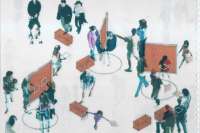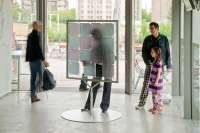Concept
Scope, movements with changing parts 2.0 draws a stagelike terrain, playfully involving visitors in movement and reflexion.
The basic concept involves the construction of several open frames, which act as the framework for individual sections, or movements. Mounted on a height-adjustable, rotating rack, every frame opens at the top. The way in which the frame is constructed makes it possible to either replace complete movements or combine two or more movements together. Every movement essentially consists of a two-sided, shallow square tray that holds fifteen square parts and one empty slot. The parts are initially placed in random order and can be slid into position until, from a single movement, coherent and interweaving motifs emerge. On the modifiable reverse side they form its counterparts.
Each part is a component of the content, is rhythmic, characterized by text and graphic schemes or so-called diagrams milled into both sides of the structure. Each part is constructed using three elements; two sheets of transparent Plexiglas are fixed to either side of a center section of semi-transparent Plexiglas. It acts as a picture, mirror or window, depending on the light source and the viewer’s position in relation to the sculpture. The figures on the structure reflect the light to varying degrees, appearing as their inverted equivalent on the opposite side. “Scope, movements with changing parts” reflects its surroundings in facets. Viewers stepping close enough to the structure appear silhouetted on the other side.
Each movement, consisting of 15 parts, has its own mobile, customized box that acts simultaneously as presentation-, carrier- and storage unit. The boxes containing the respective movements are made available to visitors in an exhibition context. I use the term "movement" in the musical sense to refer to particular forms of musical compositions consisting of several larger sections, called movements, whose interconnection and entirety make up a larger whole.
The common leitmotif of the planned movements is inversion. As a figure of thought, it serves to illustrate upheaval or a change in common patterns, as inversions problematize a tried and familiar point of view but find a clear solution for it. Represented as a tilted figure, it illustrates veering ways of thinking. Ludwig Wittgenstein describes inversion as a sudden visual metamorphosis, one that can either be generalized as a revolution in one’s view of the world or the overthrow of familiar perspectives. Inversions cause a shift in perspective, inverting an object in its mirror image. They shatter our point of view, toppling our perception of space. As Wittgenstein describes it in his Philosophical Investigations, rabbits turn to ducks and vice-versa. Suddenly illuminated, both aspects of an inverted image demonstrate the ways in which perception likens a condition, and is not a question of interpretation. Wittgenstein, however, sees the “H-E-Kopf" not only as an optical phenomenon for which one thing highlights different aspects according to context, the same is true of language games.
Marit Neeb
STUDIO Neue Schönhauser Str. 11 10178 Berlin
WERKSTATT Grosse Hamburger Str. 28 10115 Berlin
phone +49.30.2479637 mobil +49.163.2479637 mail mail@maritneeb.de web www.maritneeb.de
Concept
Scope, movements with changing parts 2.0 draws a stagelike terrain, playfully involving visitors in movement and reflexion.
The basic concept involves the construction of several open frames, which act as the framework for individual sections, or movements. Mounted on a height-adjustable, rotating rack, every frame opens at the top. The way in which the frame is constructed makes it possible to either replace complete movements or combine two or more movements together. Every movement essentially consists of a two-sided, shallow square tray that holds fifteen square parts and one empty slot. The parts are initially placed in random order and can be slid into position until, from a single movement, coherent and interweaving motifs emerge. On the modifiable reverse side they form its counterparts.
Each part is a component of the content, is rhythmic, characterized by text and graphic schemes or so-called diagrams milled into both sides of the structure. Each part is constructed using three elements; two sheets of transparent Plexiglas are fixed to either side of a center section of semi-transparent Plexiglas. It acts as a picture, mirror or window, depending on the light source and the viewer’s position in relation to the sculpture. The figures on the structure reflect the light to varying degrees, appearing as their inverted equivalent on the opposite side. “Scope, movements with changing parts” reflects its surroundings in facets. Viewers stepping close enough to the structure appear silhouetted on the other side.
Each movement, consisting of 15 parts, has its own mobile, customized box that acts simultaneously as presentation-, carrier- and storage unit. The boxes containing the respective movements are made available to visitors in an exhibition context. I use the term "movement" in the musical sense to refer to particular forms of musical compositions consisting of several larger sections, called movements, whose interconnection and entirety make up a larger whole.
The common leitmotif of the planned movements is inversion. As a figure of thought, it serves to illustrate upheaval or a change in common patterns, as inversions problematize a tried and familiar point of view but find a clear solution for it. Represented as a tilted figure, it illustrates veering ways of thinking. Ludwig Wittgenstein describes inversion as a sudden visual metamorphosis, one that can either be generalized as a revolution in one’s view of the world or the overthrow of familiar perspectives. Inversions cause a shift in perspective, inverting an object in its mirror image. They shatter our point of view, toppling our perception of space. As Wittgenstein describes it in his Philosophical Investigations, rabbits turn to ducks and vice-versa. Suddenly illuminated, both aspects of an inverted image demonstrate the ways in which perception likens a condition, and is not a question of interpretation. Wittgenstein, however, sees the “H-E-Kopf" not only as an optical phenomenon for which one thing highlights different aspects according to context, the same is true of language games.
Marit Neeb
STUDIO Neue Schönhauser Str. 11 10178 Berlin
WERKSTATT Grosse Hamburger Str. 28 10115 Berlin
phone +49.30.2479637 mobil +49.163.2479637 mail mail@maritneeb.de web www.maritneeb.de

